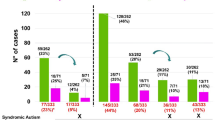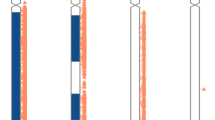Abstract
Whole-genome oligonucleotide single-nucleotide polymorphism (oligo-SNP) arrays enable simultaneous interrogation of copy number variations (CNVs), copy neutral regions of homozygosity (ROH) and uniparental disomy (UPD). Structural variation in the human genome contributes significantly to genetic variation, and often has deleterious effects leading to disease causation. Co-occurrence of CNV and regions of allelic homozygosity in tandem involving the same chromosomal arm are extremely rare. Replication-based mechanisms such as microhomology-mediated break-induced replication (MMBIR) are recent models predicted to induce structural rearrangements and gene dosage aberrations; however, supportive evidence in humans for one-ended DNA break repair coupled with MMBIR giving rise to interstitial copy number gains and distal loss of heterozygosity has not been documented. We report on the identification and characterization of two cases with interstitial triplication followed by uniparental isodisomy (isoUPD) for remainder of the chromosomal arm. Case 1 has a triplication at 9q21.11–q21.33 and segmental paternal isoUPD for 9q21.33-qter, and presented with citrullinemia with a homozygous mutation in the argininosuccinate synthetase gene (ASS1 at 9q34.1). Case 2 has a triplication at 22q12.1–q12.2 and segmental maternal isoUPD 22q12.2-qter, and presented with hearing loss, mild dysmorphic features and bilateral iris coloboma. Interstitial triplication coupled with distal segmental isoUPD is a novel finding that provides human evidence for one-ended DNA break and replication-mediated repair. Both copy number gains and isoUPD may contribute to the phenotype. Significantly, these cases represent the first detailed genomic analysis that provides support for a MMBIR mechanism inducing copy number gains and segmental isoUPD in tandem.
Similar content being viewed by others
Log in or create a free account to read this content
Gain free access to this article, as well as selected content from this journal and more on nature.com
or
References
Kearney HM, Kearney JB, Conlin LK : Diagnostic implications of excessive homozygosity detected by SNP-based microarrays: consanguinity, uniparental disomy, and recessive single-gene mutations. Clin Lab Med 2011; 31: 595–613, ix.
Papenhausen P, Schwartz S, Risheg H et al: UPD detection using homozygosity profiling with a SNP genotyping microarray. Am J Med Genet A 2011; 155A: 757–768.
Sund KL, Zimmerman SL, Thomas C et al: Regions of homozygosity identified by SNP microarray analysis aid in the diagnosis of autosomal recessive disease and incidentally detect parental blood relationships. Genet Med 2013; 15: 70–78.
Kotzot D : Complex and segmental uniparental disomy updated. J Med Genet 2008; 45: 545–556.
Liehr T, Ewers E, Hamid AB et al: Small supernumerary marker chromosomes and uniparental disomy have a story to tell. J Histochem Cytochem 2011; 59: 842–848.
Liehr T : Cytogenetic contribution to uniparental disomy (UPD). Mol Cytogenet 2010; 3: 8.
Wang JC, Fisker T, Dang L, Teshima I, Nowaczyk MJ : 4.3-Mb triplication of 4q32.1-q32.2: report of a family through two generations. Am J Med Genet A 2009; 149A: 2274–2279.
Fujita A, Suzumura H, Nakashima M et al: A unique case of de novo 5q33.3-q34 triplication with uniparental isodisomy of 5q34-qter. Am J Med Genet A 2013; 161: 1904–1909.
Rea G, Stallings RL, Mullarkey M, McKinstry CS, McManus D, Morrison PJ : Subcortical white matter abnormalities because of previously undescribed de-novo 14q12-q13.1 triplication. Clin Dysmorphol 2013; 22: 71–72.
Yamamoto T, Matsuo M, Shimada S et al: De novo triplication of 11q12.3 in a patient with developmental delay and distinctive facial features. Mol Cytogenet 2013; 6: 15.
Hastings PJ, Lupski JR, Rosenberg SM, Ira G : Mechanisms of change in gene copy number. Nat Rev Genet 2009; 10: 551–564.
Carvalho CM, Ramocki MB, Pehlivan D et al: Inverted genomic segments and complex triplication rearrangements are mediated by inverted repeats in the human genome. Nat Genet 2011; 43: 1074–1081.
Liu P, Carvalho CM, Hastings PJ, Lupski JR : Mechanisms for recurrent and complex human genomic rearrangements. Curr Opin Genet Dev 2012; 22: 211–220.
Koumbaris G, Hatzisevastou-Loukidou H, Alexandrou A et al: FoSTeS, MMBIR and NAHR at the human proximal Xp region and the mechanisms of human Xq isochromosome formation. Hum Mol Genet 2011; 20: 1925–1936.
Weischenfeldt J, Symmons O, Spitz F, Korbel JO : Phenotypic impact of genomic structural variation: insights from and for human disease. Nat Rev Genet 2013; 14: 125–138.
Madan K : Balanced complex chromosome rearrangements: reproductive aspects. A review. Am J Med Genet A 2012; 158A: 947–963.
Zhang F, Khajavi M, Connolly AM, Towne CF, Batish SD, Lupski JR : The DNA replication FoSTeS/MMBIR mechanism can generate genomic, genic and exonic complex rearrangements in humans. Nat Genet 2009; 41: 849–853.
Lee JA, Carvalho CM, Lupski JR : A DNA replication mechanism for generating nonrecurrent rearrangements associated with genomic disorders. Cell 2007; 131: 1235–1247.
Engel K, Hohne W, Haberle J : Mutations and polymorphisms in the human argininosuccinate synthetase (ASS1) gene. Hum Mutat 2009; 30: 300–307.
Gao HZ, Kobayashi K, Tabata A et al: Identification of 16 novel mutations in the argininosuccinate synthetase gene and genotype-phenotype correlation in 38 classical citrullinemia patients. Hum Mutat 2003; 22: 24–34.
Firth HV, Richards SM, Bevan AP et al: DECIPHER: database of chromosomal imbalance and phenotype in humans using Ensembl resources. Am J Hum Genet 2009; 84: 524–533.
Gentile M, Wuyts W, Grittani S et al: Clinical, cytogenetic, and molecular characterization of a patient with a de novo interstitial 22q12 duplication. Am J Med Genet A 2004; 127A: 186–190.
Stankiewicz P, Shaw CJ, Dapper JD et al: Genome architecture catalyzes nonrecurrent chromosomal rearrangements. Am J Hum Genet 2003; 72: 1101–1116.
Lee JA, Inoue K, Cheung SW, Shaw CA, Stankiewicz P, Lupski JR : Role of genomic architecture in PLP1 duplication causing Pelizaeus-Merzbacher disease. Hum Mol Genet 2006; 15: 2250–2265.
Lee JA, Madrid RE, Sperle K et al: Spastic paraplegia type 2 associated with axonal neuropathy and apparent PLP1 position effect. Ann Neurol 2006; 59: 398–403.
Hastings PJ, Ira G, Lupski JR : A microhomology-mediated break-induced replication model for the origin of human copy number variation. PLoS Genet 2009; 5: e1000327.
Schinzel AA, Brecevic L, Bernasconi F et al: Intrachromosomal triplication of 15q11-q13. J Med Genet 1994; 31: 798–803.
Author information
Authors and Affiliations
Corresponding author
Ethics declarations
Competing interests
The authors declare no conflict of interest.
Additional information
Supplementary Information accompanies this paper on European Journal of Human Genetics website
Rights and permissions
About this article
Cite this article
Sahoo, T., Wang, JC., Elnaggar, M. et al. Concurrent triplication and uniparental isodisomy: evidence for microhomology-mediated break-induced replication model for genomic rearrangements. Eur J Hum Genet 23, 61–66 (2015). https://doi.org/10.1038/ejhg.2014.53
Received:
Revised:
Accepted:
Published:
Issue date:
DOI: https://doi.org/10.1038/ejhg.2014.53
This article is cited by
-
Characterization of a rare mosaic unbalanced translocation of t(3;12) in a patient with neurodevelopmental disorders
Molecular Cytogenetics (2022)
-
16p13.11p11.2 triplication syndrome: a new recognizable genomic disorder characterized by optical genome mapping and whole genome sequencing
European Journal of Human Genetics (2022)
-
Clinical significance and mechanisms associated with segmental UPD
Molecular Cytogenetics (2021)
-
Quantitative genome-wide association analyses of receptive language in the Danish High Risk and Resilience Study
BMC Neuroscience (2020)
-
Long contiguous stretches of homozygosity detected by chromosomal microarrays (CMA) in patients with neurodevelopmental disorders in the South of Brazil
BMC Medical Genomics (2019)



